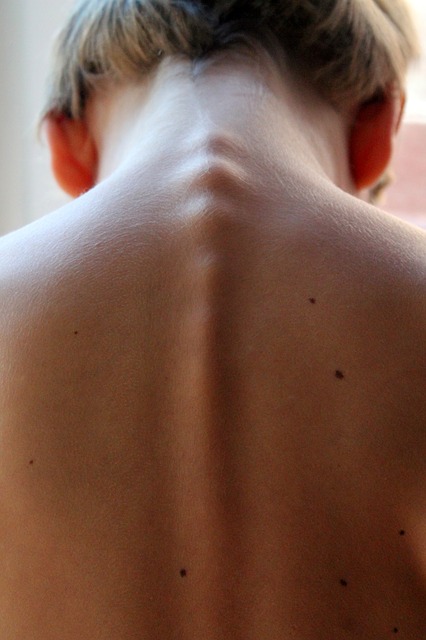 Kyphosis is a spinal deformity in which the vertebrae curve forward from the thoracic (mid-back) and sacral (low back and tail bone) regions, creating a hump appearance. The excessive roundness can happen over time due to numerous causes, the most common being osteoporosis (weakened bones). In most cases, an abnormally curved spine will cause only mild back pain or stiffness; however, in more severe cases, the person may experience difficulty breathing and fatigue, in addition to severe back pain.
Kyphosis is a spinal deformity in which the vertebrae curve forward from the thoracic (mid-back) and sacral (low back and tail bone) regions, creating a hump appearance. The excessive roundness can happen over time due to numerous causes, the most common being osteoporosis (weakened bones). In most cases, an abnormally curved spine will cause only mild back pain or stiffness; however, in more severe cases, the person may experience difficulty breathing and fatigue, in addition to severe back pain.
The team of fellowship-trained, board-certified neurosurgeons at ProMedSPINE are exceptionally skilled at treating a wide range of spine conditions, such as kyphosis. If you or a loved one is living with the uncomfortable or even painful symptoms of an excessively rounded spine, do not wait to seek treatment from the renowned back doctors at ProMedSPINE.
What Causes Spinal Curvature?
The spine is responsible for bearing the weight of the skeleton and body, while also providing flexibility and mobility. There are numerous conditions that can interfere with the spine’s natural curvature and strength, resulting in a slouched or hunched posture. The most common conditions include, but are not limited to, the following:
Osteoporosis-Related Kyphosis – Osteoporosis is a condition that causes the bones to weaken and become very brittle. The vertebrae can become so fragile that the bones fracture into a wedge shape, resulting in a stooped posture.
Postural Kyphosis – Slouching and poor posture can contribute to weakening of the abdominal and back muscles, resulting in abnormal alignment and curvature of the spine. This form may be corrected with strengthening exercises and better posture.
Congenital Kyphosis – During fetal development, a baby’s spine does not form correctly, resulting in an incomplete or unaligned spine. The condition is often treated with surgery at a young age to prevent the curvature from worsening as the child grows.
Scheuermann’s Kyphosis – A genetic condition in which an adolescent’s spine and spinal discs grow abnormally. This condition is often accompanied by mild scoliosis.
Degenerative Disc Disease – Curvature of the spine often occurs among older adults as a result of general wear and tear on the spinal column. As the spinal discs dry and degenerate due to age, the back may begin to stoop forward.
Neuromuscular Disorders – Disorders that affect a child’s neuromuscular development, such as cerebral palsy, muscular dystrophy, and spina bifida, can contribute to kyphosis.
Vitamin Deficiency – Some children may suffer from kyphosis due to nutritional deficiencies, such as low vitamin D.
Spine Injury– Traumatic spine injuries, such as dislocation or fracture, can heal improperly, causing a misaligned spinal column and kyphosis.
Learn more about the causes and symptoms of of kyphosis by visiting Mayo Clinic.
Signs and Symptoms
The most recognizable sign of any form of kyphosis is a rounded back. Depending on how extreme the curvature of the spine is, there may or may not be any other symptoms. The curvature does not necessarily cause pain or other discomfort unless it becomes excessive. Symptoms may include:
- Back pain when moving
- Mild to severe pain in the back or neck
- Soreness and stiffness
- Difficulty breathing and/or chest pains
- Fatigue
- One shoulder tilting higher than the other
Treatments for a Rounded Back
Treatment for kyphosis depends on the type and severity of the spinal curvature as well as the patient’s age and health. In many cases, treatment is not necessary. Initial treatments will typically consist of one or a combination of the following conservative, non-operative options:
- Pain relieving medications
- Bone strengthening medications
- Physical therapy
- Back or body braces
- Weight loss and healthy diet
- Calcium and/or vitamin D supplements
- Nerve blocks
In severe cases, surgery may be recommended to correct spinal curvature as well as to relieve pain. The back surgeons at ProMedSPINE regularly perform the following types of minimally invasive procedures:
Spinal Fusion – The spine is realigned and stabilized by fusing the affected vertebrae together with bone grafts, other biological material, wires, screws, rods, and cables in order to allow the spine to heal in a proper position.
Kyphoplasty – In cases where the curvature is caused by spine fractures, the collapsed vertebra are lifted and repositioned with a small balloon. Once the vertebra is in the proper alignment, a surgical cement is injected to support the spine and prevent further injury.
Osteotomy – The spine is realigned by removing a portion of the bone and allowing it to heal in its proper position.
Contact a Spine Surgical Team in Los Angeles
If you are living with abnormal spine curvature that is painful or affecting your health, you do not have to live with the pain and discomfort. The accomplished team at ProMedSPINE, led by Todd Gravori, MD, can help you find the perfect solution for your spine condition. Contact us today by calling 888-75-SPINE or simply submitting your information in an online contact form.
Next, learn about spinal tumors.